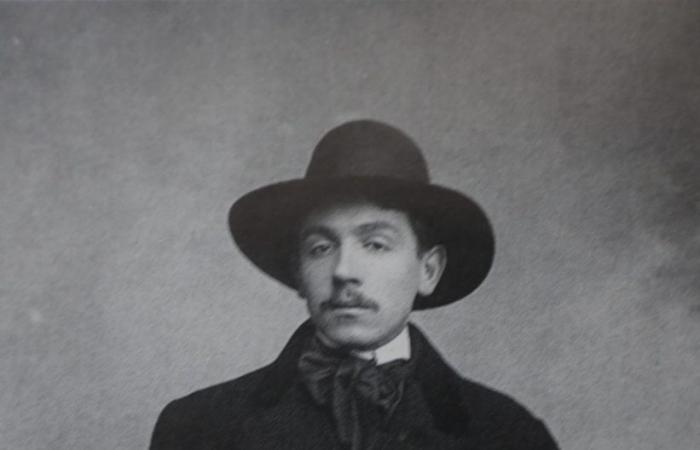
It is the story of a “dazzled discovery”. That of a sculptor, Gilbert Privat, born in 1892 in Toulouse, died in 1969 in Soulac-sur-Mer (33), by the sea, with the Dordogne. “A man who became Périgord through the best he had in him, that is to say through his wife,” wrote of him the former minister of the Périgord Popular Front and resistance fighter, Yvon Delbos. His most faithful muse.
Stéphane Klein/SO
One of the rare photos of the artist Gilbert Privat. It was on the cover of the book dedicated to him by Éditions Fanlac in 1970, shortly after his death.
This man was married to Odette de Magondeaux, who made numerous donations of his works to the Museum of the 30s, in Boulogne-Billancourt (around a hundred) and in Périgueux. “The Périgueux military museum has preserved most of its drawings produced on the front during the First World War since 1979,” explains Dominique Renaut, librarian. Or 465 drawings and watercolors. With infinite patience, he is currently digitizing them, classifying them so that the public can have access to this page of history, seen by a so-called Périgord artist. “A long-term job,” says the volunteer.
“Good quality” academicism
That he was born in Toulouse and was a Parisian in the exercise of his talents matters little. The sculptor Gilbert Privat had become a Périgourdin, spreading his works (steles and bas-reliefs) to the four corners of the department. From Périgueux to Montignac, from Boulazac to Sarlat.
At the military museum, he left a multitude of portraits sketched in the second line, when, wounded four times, he had to seek treatment. Incorporated into the 15th Albi infantry regiment in October 1913, private 1st class in June 1914, Gilbert Privat was demobilized in August 1919 with the rank of sergeant, holder of the Croix de Guerre. Drawn on makeshift papers, “with what he found,” these portraits have a universal significance. They tell of the turmoil, the war, the waiting in few words.
Returned to civilian life, Gilbert Privat was able to devote himself to his art in Paris, which earned him a second Grand Prix de Rome in 1921. His marriage in 1937 to a native of Thiviers in Dordogne, who was elected to Paris in 1952, made him take the turn for Périgord. The prefectural town preserves its memory, in particular at the Museum of Art and Archeology of Périgord (Maap).
“Look at these curves, this softness. It’s graceful, fine, pure.”
Gilbert Privat particularly expressed his talent in the aesthetic research of the female body. “Look at these curves, this softness. It’s graceful, fine, pure,” comments Myriam Grenier, deputy director of Maap. The museum has 87 works by the artist, including 20 bas-reliefs and six watercolors. A small room is dedicated to him. The majority are sculptures like this stone maternity ward, which was inaugurated in 1946 in front of the maternity ward of the Périgueux hospital. There will be others.
His “good” academicism, inspired by Greco-Roman sculptures, also gave way at the end of his life to more original works, notably intimate bronzes. Who was this artist “up early, went to bed late, slept little, worked a lot with a pipe in his mouth and a Basque beret on his head”, according to his late wife, also deceased?
Open air
He showed an artistic streak very early on, encouraged by his father, a wood sculptor, who trained him in his workshop. He then enrolled at the École des Beaux-Arts in Toulouse, then at the École nationale supérieure des Beaux-Arts in Paris. After his mobilization during the First World War, and his first laurels, he enjoyed a great reputation, which led to a series of exhibitions in Parisian salons. His breakthrough in Périgord dates from after the Second World War.
His open-air sculptures are still mostly on display in the streets of Périgueux, one of which bears his name. Starting with the Mur des Fusillés, inaugurated in 1954, in homage to 45 hostages who were shot, and several bas-reliefs such as his work on the history of Périgord at the theatre (former village hall, 1960), a series of 15 panels of which only seven remain. He is also responsible for the sculptures of Fénélon (1962) and Montaigne (1961), allées de Tourny.
“He was very eclectic. A sculptor, he worked with plaster, staff, earth, bronze, tackling stone and marble or slate, but he was also a watercolorist and painter,” underlines the Maap. A poet, who loved the Dordogne. His contemporaries preserved some of his poems in a posthumous work, published by Editions Fanlac, after his death in 1969. “In Périgord, blessed by lovers and the Gods, I stop, to try to say, untranslatable into wax, beauty, harmony, enclosed in these places. Like. Let us collect ourselves. Delicious Périgord. » Thus spoke the man.




